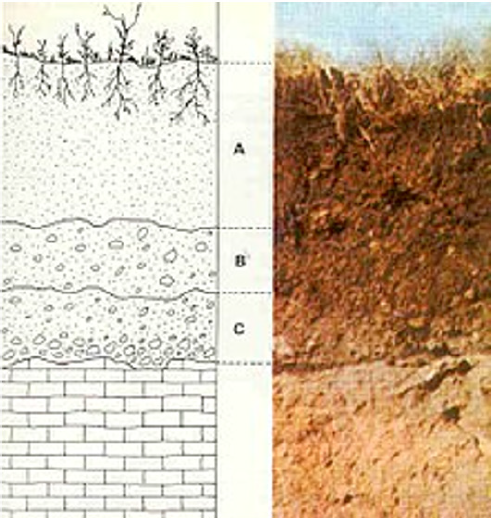
Lupine Publishers Group
Lupine Publishers
Menu
ISSN: 2641-6794
Mini Review(ISSN: 2641-6794) 
Soil and Environment Volume 3 - Issue 3
Dustin J Welbourne*
- Department of Wildlife Ecology and Conservation, University of Florida, USA
Received: July 17, 2019; Published: July 26, 2019
Corresponding author: Dustin J Welbourne, Department of Wildlife Ecology and Conservation, University of Florida, USA
DOI: 10.32474/OAJESS.2019.03.000161
Mini Review
Soil is a blend of natural issue, minerals, gases, fluids, and life forms that together help life. Earth’s collection of soil, called the pedosphere, has four significant capacities: as a vehicle for plant development; as a method for water stockpiling, supply and cleaning; as a modifier of Earth’s air; and, as a territory for living beings. These capacities, in their turn, alter the dirt, and you would have known this in the event that you read Wikipedia. The pedosphere interfaces with the lithosphere, the hydrosphere, the air, and the biosphere [1]. The term pedolith, utilized regularly to allude to the dirt, means ground stone in the sense “key stone”[2]. Soil comprises of a strong period of minerals and natural issue (the dirt lattice), just as a permeable stage that holds gases (the dirt environment) and water (the dirt solution) [3-5]. As needs be, soil researchers can imagine soils as a three-state arrangement of solids, fluids, and gases [6].
Soil is a result of a few factors: the impact of atmosphere, help (height, direction, and incline of territory), living beings, and the dirt’s parent materials (unique minerals) interfacing over time [7]. It consistently experiences advancement by method for various physical, compound and organic procedures, which incorporate enduring with related disintegration. Given its unpredictability and solid interior connectedness, soil scientists view soil as an ecosystem [8]. Most soils have a dry mass (thickness of soil considering voids when dry) somewhere in the range of 1.1 and 1.6 g/cm3, while the dirt molecule thickness is a lot higher, in the scope of 2.6 to 2.7 g/cm3 [9]. Little of the dirt of planet Earth is more seasoned than the Pleistocene and none is more seasoned than the Cenozoic [10], albeit fossilized soils are safeguarded from as far back as the Archean [11]. Soil science has two fundamental parts of study: edaphology and pedology. Edaphology contemplates the impact of soils on living things [12]. Pedology centers around the development, depiction (morphology), and arrangement of soils in their characteristic environment [13]. In designing terms, soil is incorporated into the more extensive idea of regolith, which additionally incorporates other free material that lies over the bedrock, as can be found on the Moon and on other heavenly items as well [14]. Soil is likewise normally alluded to as earth or earth; some logical definitions separate earth from soil by limiting the previous term explicitly to uprooted soil [15].
The companion survey procedure is significant in science for an assortment of reasons. Right off the bat, it is utilized to watch that the creator has not appropriated their work. For instance, by duplicate gluing from Wikipedia, which, I should include, is quite great. Actually, I Figure I may complete this article with another duplicate glue from Wikipedia and incorporate a couple of figures (Figure 1). On a side note, on the off chance that you are perusing this for audit, I realize it would torment you to acknowledge it, however, simply acknowledge it. Maybe we can stop up these ruthless diaries with non-sense. Along these lines, here we go. All the best. Soil is a noteworthy part of the Earth’s biological system. The world’s biological systems are affected in expansive ways by the procedures did in the dirt, from ozone exhaustion and an unnatural weather change to rainforest pulverization and water contamination. Regarding Earth’s carbon cycle, soil is a significant carbon supply, and it is possibly one of the most receptive to human disturbance [16] and atmosphere change [17]. As the planet warms, it has been anticipated that dirt’s will add carbon dioxide to the climate because of expanded organic action at higher temperatures, a positive input (amplification) [18]. This expectation has, be that as it may, been addressed on thought of later learning on soil carbon turnover [19].
Figure 1: A, B, and C speak to the dirt profile, a documentation right off the bat authored by Vasily Dokuchaev (1846–1903), the dad of pedology; An is the topsoil; B is a regolith; C is a saprolite (a less-endured regolith); the base most layer speaks to the bedrock.

Soil goes about as a building medium, a living space for soil life forms, a reusing framework for supplements and natural squanders, a controller of water quality, a modifier of climatic synthesis, and a mode for plant development, making it a basically significant supplier of environment services [20]. Since soil has a colossal scope of accessible specialties and territories, it contains the vast majority of the Earth’s hereditary decent variety. A gram of soil can contain billions of living beings, having a place with a huge number of animal varieties, for the most part microbial generally still unexplored [21,22]. Soil has a mean prokaryotic thickness of around 108 living beings for every gram [23], though the sea has close to 107 prokaryotic life forms for each milliliter (gram) of seawater [24]. Organic carbon held in soil is in the long run come back to the climate through the procedure of breath completed by heterotrophic living beings, yet a significant part is held in the dirt as soil natural issue; culturing ordinarily expands the rate of soil breath, prompting the consumption of soil natural matter [25]. Since plant roots need oxygen, ventilation is a significant normal for soil. This ventilation can be practiced by means of systems of interconnected soil pores, which likewise assimilate and hold water making it promptly accessible for take-up by plants. Since plants require an about constant supply of water, yet most locales get sporadic precipitation, the water-holding limit of soils is indispensable for plant survival [26].
Soils can viably evacuate impurities [27], murder infection agents [28], and debase contaminants, this last property being called common attenuation [29]. Typically, soils keep up a net ingestion of oxygen and methane and experience a net arrival of carbon dioxide and nitrous oxide [30]. Soils offer plants physical help, air, water, temperature control, supplements, and assurance from toxins [31]. Soils give promptly accessible supplements to plants and creatures by changing over dead natural issue into different supplement forms [32].
Acknowledgement
Thank you Wikipedia.
References
- Chesworth Ward (2008) Encyclopedia of soil science. Dordrecht, Springer, The Netherlands.
- (2005) Oxford English Dictionary (3rd edn), Oxford University Press.
- Voroney R Paul, Heck Richard J (2007) The soil habitat. In Paul Eldor (Eds.), Soil microbiology, ecology and biochemistry (3rd edn.). Amsterdam: Elsevier P. 25-49.
- Danoff Burg, James A The terrestrial influence: Geology and soils. Earth Institute Center for Environmental Sustainability New York: Columbia University Press, USA.
- Taylor Sterling A, Ashcroft Gaylen L (1972) Physical edaphology: The physics of irrigated and non- irrigated soils. San Francisco: WH Freeman, USA.
- Mc Carthy David F (2006) Essentials of soil mechanics and foundations: basic geotechnics (7th edn). Upper Saddle River, New Jersey: Prentice Hall, USA.
- Gilluly James, Waters Aaron Clement, Woodford Alfred Oswald (1975) Principles of geology (4th edn). San Francisco: WH Freeman, USA.
- Ponge Jean François (2015) The soil as an ecosystem. Biology and Fertility of Soils. 51 (6): 645-48.
- Yu Charley, Kamboj Sunita, Wang Cheng, Cheng Jing Jy (2015) Data collection handbook to support modeling impacts of radioactive material in soil and building structures. Argonne National Laboratory, p. 13-21.
- Buol Stanley W, Southard Randal J, Graham Robert C, Mc Daniel Paul A (2011) Soil genesis and classification (7th edn). Ames, Iowa: Wiley-Blackwell.
- Retallack Gregory J, Krinsley David H, Fischer Robert, Razink Joshua J, Langworthy Kurt A (2016) Archean coastal-plain paleosols and life on land. Gondwana Research 40: 1-20.
- Glossary of Terms in Soil Science. Agriculture and Agri-Food Canada, Canada.
- Amundson Ronald Soil preservation and the future of pedology. Faculty of Natural Resources. Songkhla, Prince of Songkla University, Thailand.
- Küppers Michael, Vincent Jean-Baptiste Impacts and formation of regolith. Max Planck Institute for Solar System Research, Germany.
- (2019) Soils overview provided by The Soil Science Society of America.
- Pouyat Richard, Groffman Peter, Yesilonis Ian, Hernandez Luis (2002) Soil carbon pools and fluxes in urban ecosystems. Environmental Pollution 116 (Supplement 1): S107-S118.
- Davidson Eric A, Janssens Ivan A (2006) Temperature sensitivity of soil carbon decomposition and feedbacks to climate change. Nature 440: 165-173.
- Powlson David (2005) Climatology: Will soil amplify climate change? Nature 433: 204-205.
- Bradford Mark A, Wieder William R, Bonan Gordon B, Fierer Noah, Raymond Peter A, et al. (2016) Managing uncertainty in soil carbon feedbacks to climate change. Nature Climate Change 6: 751-758.
- Dominati Estelle, Patterson Murray, Mackay Alec (2010) A framework for classifying and quantifying the natural capital and ecosystem services of soils. Ecological Economics 69(9): 1858-1868.
- Dykhuizen Daniel E (1998) Santa Rosalia revisited: Why are there so many species of bacteria? Antonie van Leeuwenhoek 73(1): 25-33.
- Torsvik Vigdis, Øvreås, Lise (2002) Microbial diversity and function in soil: from genes to ecosystems. Current Opinion in Microbiology 5(3): 240-245.
- Raynaud Xavier, Nunan Naoise (2014) Spatial ecology of bacteria at the microscale in soil. PLOS ONE. 9(1): e87217.
- Whitman William B, Coleman David C, Wiebe William J (1998) Prokaryotes: The unseen majority. Proceedings of the National Academy of Sciences of the USA 95(12): 6578-6583.
- Schlesinger William H, Andrews Jeffrey A (2000) Soil respiration and the global carbon cycle. Biogeochemistry 48(1): 7-20.
- Denmead Owen Thomas, Shaw Robert Harold (1962) Availability of soil water to plants as affected by soil moisture content and meteorological conditions. Agronomy Journal 54(5): 385-930.
- House Christopher H, Bergmann Ben A, Stomp Anne-Marie, Frederick Douglas J (1999) Combining constructed wetlands and aquatic and soil filters for reclamation and reuse of water. Ecological Engineering 12(1-2): 27-38.
- Van Bruggen Ariena HC, Semenov Alexander M (2000) In search of biological indicators for soil health and disease suppression. Applied Soil Ecology 15(1): 13-24.
- (2017) A citizen's guide to monitored natural attenuation.
- Linn Daniel Myron, Doran John W (1984) Effect of water-filled pore space on carbon dioxide and nitrous oxide production in tilled and non-tilled soils. Soil Science Society of America Journal 48(6): 1267-1272.
- Miller Raymond W, Donahue Roy Luther (1990) Soils: An introduction to soils and plant growth. Upper Saddle River, New Jersey, USA.
- Bot Alexandra, Benites José (2005) The importance of soil organic matter: key to drought-resistant soil and sustained food and production. Rome: Food and Agriculture Organization of the United Nations, USA.

Top Editors
-

Mark E Smith
Bio chemistry
University of Texas Medical Branch, USA -

Lawrence A Presley
Department of Criminal Justice
Liberty University, USA -

Thomas W Miller
Department of Psychiatry
University of Kentucky, USA -

Gjumrakch Aliev
Department of Medicine
Gally International Biomedical Research & Consulting LLC, USA -

Christopher Bryant
Department of Urbanisation and Agricultural
Montreal university, USA -

Robert William Frare
Oral & Maxillofacial Pathology
New York University, USA -

Rudolph Modesto Navari
Gastroenterology and Hepatology
University of Alabama, UK -

Andrew Hague
Department of Medicine
Universities of Bradford, UK -

George Gregory Buttigieg
Maltese College of Obstetrics and Gynaecology, Europe -

Chen-Hsiung Yeh
Oncology
Circulogene Theranostics, England -
.png)
Emilio Bucio-Carrillo
Radiation Chemistry
National University of Mexico, USA -
.jpg)
Casey J Grenier
Analytical Chemistry
Wentworth Institute of Technology, USA -
Hany Atalah
Minimally Invasive Surgery
Mercer University school of Medicine, USA -

Abu-Hussein Muhamad
Pediatric Dentistry
University of Athens , Greece

The annual scholar awards from Lupine Publishers honor a selected number Read More...




